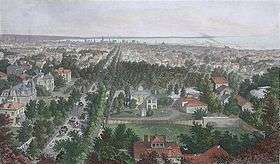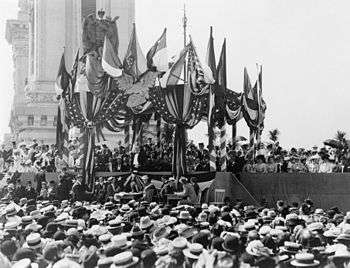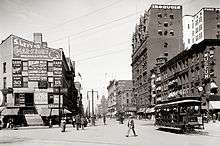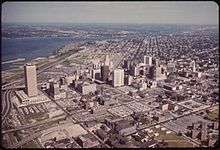History of Buffalo, New York


This article is about the history of Buffalo, New York. Buffalo is the second most populous city in the state of New York, after New York City. Originating around 1789 as a small trading community near the mouth of Buffalo Creek, Buffalo grew quickly after the opening of the Erie Canal in 1825, with the city as its western terminus.
Origin of name

The City of Buffalo, formerly known as Buffalo Creek, received its name from the creek that flows through it. However, the origin of the creek's name is unclear, with several unproven theories existing. Early French explorers reported the abundance of buffalo on the south shore of Lake Erie, but their presence on the banks of Buffalo Creek is still a matter of debate, although American Bison did range into western NY state at one time. Neither the Native American name Teyohoseroron (the Place of the Basswoods) nor the French name Riviere aux Chevaux (River of Horses) survived, so the current name likely dates to the British occupation which began with the capture of Fort Niagara in 1759.
Another theory holds that a Seneca Indian lived there, either whose name meant buffalo, or who had the physical characteristics of a buffalo, and was translated as such by the English settlers. The stream where he lived became Buffalo's Creek. Unlike other nearby creeks such as Scajaquada Creek and Smoke's Creek which were named after actual historic figures, there is no known reference to any Native American named Buffalo. Also given credence by local historians at one time was the possibility that an interpreter mistranslated the Native American word for "beaver" as "buffalo," the words being very similar, at a treaty-signing at present-day Rome, New York in 1784. The theory assumes that because there were beaver here, the creek was probably called Beaver Creek rather than Buffalo Creek.
Another theory holds that the name is an anglicized form of the French name Beau Fleuve (beautiful river), which was supposedly an exclamation uttered by Louis Hennepin when he first saw the Niagara River. This is a relatively recently proposed theory (1909) and is unlikely, as no period sources contain this quote. The earliest known name origin theory is an anecdote told to Captain Daniel Dobbins by Cornelius Winney in 1795 and also found with variations in Sheldon Ball's History of Buffalo (1825) and other sources, about a party of hunters whose guide shoots a horse and passes it off as bison meat, thereafter the origin of the term "buffaloed."
Despite many years of speculation and garbling of previous debate, more recently available sources indicate that the name Buffalo Creek was in common use on the Niagara Frontier by 1764, as John Montresor referenced 'Buffalo Creek' in his journal of that year.[2] The name may have originated with an English speaking person sometime between 1759 and 1764, possibly after seeing animal bones, thought to be bison but possibly elk or moose or domesticated cattle, at the salt lick called Sour Springs located at the head of navigation about 6 miles up the creek.
Early history
| Historical population | |||
|---|---|---|---|
| Census | Pop. | %± | |
| 1830 | 8,668 | — | |
| 1840 | 18,213 | 110.1% | |
| 1850 | 42,261 | 132.0% | |
| 1860 | 81,129 | 92.0% | |
| 1870 | 117,714 | 45.1% | |
| 1880 | 155,134 | 31.8% | |
| 1890 | 255,664 | 64.8% | |
| 1900 | 352,387 | 37.8% | |
| 1910 | 423,715 | 20.2% | |
| 1920 | 506,775 | 19.6% | |
| 1930 | 573,076 | 13.1% | |
| 1940 | 575,901 | 0.5% | |
| 1950 | 580,132 | 0.7% | |
| 1960 | 532,759 | −8.2% | |
| 1970 | 462,768 | −13.1% | |
| 1980 | 357,870 | −22.7% | |
| 1990 | 328,123 | −8.3% | |
| 2000 | 292,648 | −10.8% | |
| 2010 | 261,310 | −10.7% | |
| source:[3] | |||
Amerindian Crossroads
The societies of the Native Forest dwellers we know as Native Americans, Amerindians, or First Nations made highways of the Great Lakes, streams and were far more social than their reputed penchant for warfare, cruelty, and collecting scalps would suggest. Their canoes were built from lightweight birch bark, or far more often, Elm, the farther south the tribe, the more likely Elm was the material used for many purposes including the canoes. Buffalo, near the throat of the Niagara River, was a popular campsite for voyaging tribesmen, in a culture which often went on walk-abouts, touring neighboring lands and conducting the widespread practice of boy-meets-girl, trading of regional commodities.[lower-alpha 1]

Prior to European colonization by French settlers, the region's inhabitants were an Iroquoian-speaking tribal offshoot called the Wenro people or 'Wenrohronon', who lived along the south shore of Lake Ontario and east end of Lake Erie and a bit of its southern shore. The population of the Wenro was small by comparison to other Iroquoian tribes the French encountered and reported upon, possibly because they'd only recently split off from other groups or because they'd suffered the misfortunes of war. They were possibly (most likely) a sub-group of the main Neutral Confederacy which had colonized the opposite shore, or possibly relatives of the great abutting neighboring Erie Nation,[lower-alpha 2] which extended southwesterly through most of present-day Ohio, Western Pennsylvania and West Virginia.
The American Heritage Book of Indians points out there are opposing (on the surface) contradictory theories[lower-alpha 3] of the origination and the migration of the Iroquois and Iroquoian peoples that came to inhabit the region around Buffalo and the Niagara River.[lower-alpha 4]
The French found the Neutral groups helpful in mediating disputes with other tribes—in particular the League of the Iroquois which became sworn enemies of the French from their first meeting in 1609.[lower-alpha 5] By comparison, the Huron also an Iroquoian people, were often at odds with the Iroquois once European traders offered highly desired goods for furs, especially water proof Beaver pelts[lower-alpha 6] About 1651 the Iroquois Confederacy declared war on the Neutrals; by 1653, the Confederacy, particularly the Senecas, had practically annihilated the Neutrals[4][5] and the splinter tribe of Wenro people. The Wenro's area was subsequently populated by the Seneca tribe.
Also in 1653 the large and populous Erie tribe, having taken in survivors of the Huron, Neutral, Wenro, and Tabacco peoples—Iroquoian peoples one and all, with traditions of adopting outsiders—received demands to send Neutrals to the Iroquois and instead launched an preemptive attack on the League, kicking off three years of desperate warfare that eventually shattered the Erie and bled the Iroquois of much of their strength.[lower-alpha 7] Ohio and Western Pennsylvania became nearly vacant Iroquois hunting grounds, exploited for furs, but ten years later the Iroquois, having also adopted tribal members of peoples they'd recently thrashed, found themselves in a new war with the Susquehannocks who lived down below the Allegheny Front, the escarpment above most of today's central Pennsylvania along the Susquehanna River valleys—another people believed to have significantly outnumbered the Iroquois[lower-alpha 8] —so warring along the Susquehanna Valley from lower New York to Maryland through central Pennsylvania. In 1667-68 the Susquehannocks nearly wiped out two of the Five Iroquois people. At that point the Susquehannock's suffered one or more horrendous plagues, losing up to 90% of their population and military capabilities. By 1672 the Iroquois became the proverbial 'Last Man Standing' in the Northern Beaver Wars, and one
First Europeans
Most of western New York was granted by Charles II of England to the Duke of York (later King James II & VII), but the first European settlement in what is now Erie County was by the French, at the mouth of Buffalo Creek in 1758. Its buildings were destroyed a year later by the evacuating French after the British captured Fort Niagara. The British took control of the entire region in 1763, at the conclusion of the French and Indian War. In 1764, British military engineer John Montresor made an inspection tour of Buffalo Creek before determining on a site for a fortification on the opposite shore. After the 1779 Sullivan Expedition, the British settled Seneca refugees in several villages on Buffalo Creek in the spring of 1780.
The first permanent settlers in present-day Buffalo were Cornelius Winney and "Black Joe" Hodges, who set up a log cabin store there in 1789 for trading with the Native American community. British interpreter William Johnston was another early settler. The British retained control of the area and prevented further settlement by Americans until their evacuation of Fort Niagara in 1796.
Dutch investors purchased the area from the Seneca Indians as part of the Holland Purchase. Although other Senecas were involved in ceding their land, the most famous today is Red Jacket, who died in Buffalo in 1830. His grave is in Forest Lawn Cemetery. Starting in 1801, parcels were sold through the Holland Land Companies office in Batavia, New York. The settlement was initially called Lake Erie, then Buffalo Creek, soon shortened to Buffalo. Holland Land Company agent Joseph Ellicott christened it New Amsterdam, but the name did not catch on.[6] In 1808, Niagara County was established with Buffalo as its county seat. Erie County was formed out of Niagara County in 1821, retaining Buffalo as the county seat.
The 19th century


In 1804, Joseph Ellicott, a principal agent of the Holland Land Company, designed a radial street and grid system that branches out from downtown like bicycle spokes, and is one of only three radial street patterns in the US . In 1810, the Town of Buffalo was formed from the western part of the Town of Clarence. On December 30, 1813, during the War of 1812, British troops and their Native American allies first captured the village of Black Rock, and then the rest of Buffalo, burning most of both to the ground. Buffalo gradually rebuilt itself and by 1816 had a new courthouse. In 1818, the eastern part of the town was lost to form the Town of Amherst.
Upon the completion of the Erie Canal in 1825, Buffalo became the western end of the 524-mile waterway starting at New York City. At the time, Buffalo had a population of about 2,400 people. With the increased commerce of the canal, the population boomed and Buffalo was incorporated as a city in 1832. On 1 June 1843, the world's first steam-powered grain elevator was put into service by a local merchant, Joseph Dart, Jr., and an engineer, Robert Dunbar. The "Dart Elevator" would remain standing until 1862, when it burned down. During the 1840s and 1850s, more than a dozen grain elevators were built in Buffalo's harbor, most of them designed by Dunbar.[7]
In 1853, Buffalo annexed Black Rock, which had been Buffalo's fierce rival for the canal terminus. During the 19th century, thousands of pioneers going to the western United States debarked from canal boats to continue their journey out of Buffalo by lake or rail transport. During their stopover, many experienced the pleasures and dangers of Buffalo's notorious Canal district.
Buffalo was a terminus of the Underground Railroad, an informal series of safe houses for African-Americans escaping slavery in the mid-19th century. Buffalonians helped many fugitives cross the Niagara River to Fort Erie, Ontario, Canada and freedom.
U.S. Presidents and Buffalo



Several U.S. presidents have had connections with Buffalo.
- Millard Fillmore took up permanent residence in Buffalo in 1822 before he became America's 13th president. He was also the first chancellor of the University of Buffalo, now known as SUNY University at Buffalo.
- Grover Cleveland, the 22nd and 24th President of the United States, lived in Buffalo from 1854 until 1882, and served as Buffalo's mayor from 1882 until 1883.
- William McKinley was shot by Leon Czolgosz on September 6, 1901 at the Pan-American Exposition in Buffalo, and died in Buffalo on the 14th.
- Theodore Roosevelt was then sworn in on September 14, 1901 at the Ansley Wilcox Mansion, now the Theodore Roosevelt Inaugural National Historic Site, becoming one of the few presidents to be sworn in outside of Washington, D.C..
The 20th century
Around the start of the 20th century, Buffalo was a growing city with a burgeoning economy. Immigrants came from Ireland, Italy, Germany, and Poland to work in the steel and grain mills which had taken advantage of the city's critical location at the junction of the Great Lakes and the Erie Canal. Hydroelectric power harnessed from nearby Niagara Falls made Buffalo the first American city to have widespread electric lighting yielding it the nickname, the "City of Light". Electricity was used to dramatic effect at the Pan-American Exposition in 1901. The Pan-American was also notable for being the scene of the aforementioned assassination of President William McKinley.
The opening of the Peace Bridge linking Buffalo with Fort Erie, Ontario on August 7, 1927 was an occasion for significant celebrations.
The Great Depression of 1929-39 saw severe unemployment, especially among working class men. The New Deal relief programs operated full force. The city became a stronghold of labor unions and the Democratic Party.[8] Buffalo's City Hall, an Art Deco masterpiece, was dedicated on July 1, 1932.
The city's importance declined in the later half of the 20th century for several reasons, perhaps the most devastating being the opening of the St. Lawrence Seaway in 1957. Goods which had previously passed through Buffalo could now bypass it using a series of canals and locks, reaching the ocean via the St. Lawrence River. Another major toll was suburban migration, a national trend at the time. Race riots rocked the city in 1967.[9] The city, which boasted over half a million people at its peak, has seen its population decline by some 50%, as industries shut down and people left the Rust Belt for the employment opportunities of the South and West. Erie County has lost population in every census year since 1970.
The 21st century
On July 3, 2003, at the climax of a fiscal crisis, the Buffalo Fiscal Stability Authority was established[10] to oversee the finances of the city. As a "hard control board," they have frozen the wages of city employees and must approve or reject all major expenditures. After a period of severe financial stress, Erie County, where Buffalo resides, was assigned a Fiscal Stability Authority on July 12, 2005. As a "soft control board," however, they act only in an advisory capacity.[11] Both Authorities were established by New York State. In November 2005, Byron Brown was elected Mayor of Buffalo. He is the first African-American to hold this office.
Economic development in the city was marked at $3.5 billion in 2006 compared to the ten year previous average of $50 million . New proposals and renovations were numerous, especially in the downtown area. Buffalo ranked 83rd on the Forbes best cities for jobs list, an increase from the previous year, beating out cities like New York City, Cleveland, and Detroit.
See also
Notes
- ↑ Obsidian from Canada, Flint, shells, plants are all known to have traveled hundreds-to-thousands of miles carried by a sociable people that often met recreationally as well for competions—for Lacrosse—the picture of the Amerindian tribes as blood thirsty savages would never have lasted in the light of day, had the natives not been cut down by diseases they had little resistance to.
- ↑ It is also possible they were a combination of clan groups from differing peoples. The Iroquoian culture was one with a matrilineal clan basis, the women selecting the leading men. It would be odd if at such a prime meeting place as the river-Lake outlet area that a people which by all accounts traveled often, that men and women and whole tribal groups didn't meet and mingle in such a idyllic surround.
- ↑ Amerindian studies scholars believe the known Iroquoian nations coalesced about 1300 and either migrated from the Carolina's to the Great Lakes, or originated along the St. Lawrence and moved westward and south. Either way, by 300 years later the various Iroquoian peoples dominated the area of the right bank St. Lawrence River to the Eastern side of Lake Huron dominating half the shores of the Great Lakes from the tip of present-day Northern Maine and New England nearly to Western Ohio, and extended southerly from the northern shores beyond Lake Huron's Georgian Bay (Huron) down along the Susquehanna and parts of Chesapeake Bay. Concurrently as the 1600s brought European fur traders and then colonies, two large Iroquoian nations, the Tuscarora people and the Cherokee people occupied lands south of the Province of Virginia on either side of the Appalachians barrier range; west of the lower Appalachians, the Cherokee held territory in Kentucky and Tennessee.
- ↑ French colonialism and the process of settlements used the English were very different modalities; the French Crown monopolized American economic activity: traders, and a relatively few number of settlers danced to the Crown's policies, and cultivated good relations with Amerindian tribe and nations. In the French, Dutch, and English disputes that followed, the undermanned French were dependent upon their Amerindian allies for manpower, and most military power. In contrast, the English mercantilism driven colonialism—later in the 1700s, British—almost universally established an initial tolerance seguing soon after settlements became well established to an mode of oft ruthless exploitation and patterns of confrontation, racial prejudice, and land grabs; the English/British class-conscience culture almost uniformly ended up in frontier tension and eventual interracial conflict leading to an succession of wars, of displaced Native American tribes. The English modality had little direct frontier impact effect around Buffalo but the Indian vs. Indian events in the region are illustrative of both Kingdoms practices and the Iroquois grudge against the French.
- ↑ In 1609 Champlain assisting a mixed war party of Huron and Algonquian raiding the Mohawk Nation, ironically along the Lake now named for him, killed two of three Mohawk war sachems, wounding the third and built up an enmity from the Iroquois that would last 150 years, until the end of the French and Indian War (1756-1763) drove the French from North America. This encounter is an epoch, beginning a period now loosely referred to as the Beaver Wars in which over 60 years of internecine Amerindian on Indian battles, giving the Iroquois the balance of North American political power for the next hundred. The Beaver Wars for many years were believed to be mainly economic. Recent scholarship has posed several other factors, most steeped in the culture and religious beliefs of the disparate Iroquoian peoples.
- ↑ the Huron territory started in the upper St. Lawrence valley, and the Iroquois claimed virtually all of the opposite bank; so were in competition in the European Goods sweepstakes.
- ↑ One of the Iroquois few periods of peace occurred, giving evidence of the savvy political sophistication the Iroquois would now become famous for having; a similar peace was negotiated when the Susquehannock and Iroquois fought—the council ruling the Iroquois did not want Algonkian raiding while taking on militarily strong opponents.
- ↑ The American Heritage Book of Indians discuss a French report (New France was a direct venture of the King, the Jesuits sent back reports every year for decades) ca. 1660s-1670s that the adopted Iroquois outnumbered the Native Iroquois in that period.
Further reading
- Coffey, Brian, and Allen G. Noble. "Mid-nineteenth century housing in Buffalo, New York." Material Culture 28.3 (1996): 1-16. in JSTOR
- Gerber, David A. The Making of an American Pluralism: Buffalo, New York, 1825-60 (Univ of Illinois Press, 1989).
- Jenkins, William. "In Search of the Lace Curtain: Residential Mobility, Class Transformation, and Everyday Practice among Buffalo’s Irish, 1880—1910." Journal of Urban History 35.7 (2009): 970-997.
- Kohler, C. Douglas, and Julianna L. Woite. Clarence (Arcadia Publishing, 2012), a suburb
- Rizzo, Michael F. Through the Mayors' Eyes: Buffalo, New York 1832-2005 (Lulu.com, 2005).
- Rockwell, Mary Rech. "Elite Women and Class Formation." in by Julia B. Rosenbaum and Sven Beckert, eds. The American Bourgeoisie: Distinction and Identity in the Nineteenth Century (Palgrave Macmillan US, 2010). 153-166.
- Smith, Henry Perry. History of the City of Buffalo and Erie County (2 vol. 1884).
- Taylor, Steven J.L. Desegregation in Boston and Buffalo: The influence of local leaders (SUNY Press, 1998).
- Williams, Lillian Serece. Strangers in the Land of Paradise: The Creation of an African American Community in Buffalo, New York, 1900-1940 (Indiana University Press, 2000).
Old primary sources
- A directory for the city of Buffalo, Buffalo: L.P. Crary, 1832, OCLC 35591891
- History of the City of Buffalo and Erie County, 1884
- Kuebler, Albert J., (1894), Knights of Pythias directory and Buffalo street directory and guide ..., Buffalo, N.Y: Kraft & Stern, printers
References
- ↑ Lossing, Benson (1868). The Pictorial Field-Book of the War of 1812. Harper & Brothers, Publishers. p. 380.
- ↑ Severance, Frank H. (1902). "The Achievements of Captain John Montresor". In Buffalo Historical Society. Buffalo Historical Society Publications. Buffalo, NY: Bigelow Brothers. p. 15. Retrieved August 14, 2015.
- ↑ US Population of the 100 Largest Cities and other Urban Places in the United States: 1790 to 1990 Census.gov
- ↑ Catholic Encyclopedia, "The Hurons"
- ↑ Reville 1920, p.20.
- ↑ Clinton, George W.; Hunt, Sanford B. (1862). Thomas' Buffalo City Directory for 1862, to which is Prefixed a Sketch of the Early History of Buffalo, Followed by a Glance at its Progress down to the Present Time. Buffalo, NY: E.A. Thomas, Franklin Steam Printing House. p. 16. Retrieved August 31, 2015.
- ↑ American Colossus: the Grain Elevator 1843-1943 (Colossus Books, 2009) www.american-colossus.com
- ↑ Lewis Lansky, "Buffalo and the Great Depression, 1929-1933," in Milton Plesur, ed., American Historian: Essays to Honor Selig Adler (1980), pp 204-13
- ↑ "The Circle Association's African American History of Western New York State, 1935 to 1970"
- ↑ Official Site of the Buffalo Fiscal Stability Authority www.bfsa.state.ny.us
- ↑ Erie County Fiscal Stability Authority www.ecfsa.state.ny.us